Gradation Design of Phosphorus Tailing–Graded Waste Rock Subgrade Filling Using Discrete Element Method
Abstract
:1. Introduction
2. Materials and Methods
2.1. Phosphorus Tailing and Its Application in Filling Engineering
2.2. Graded Waste Rock
3. Establishment of Mixture Discrete Element Model
3.1. Graded Mixing Method for Coarse Aggregate
3.2. PFC3D Simulation
3.2.1. Parameter Setting
3.2.2. Particle Generation
3.2.3. Mixture Balance and Calculation of Mixture Porosity
4. Determination and Evaluation of Gradation of Phosphorus Tailing–Waste Rock Mixture
4.1. Determination of Coarse Aggregate Gradation of Phosphorus Tailing–Gravel Mixture
4.1.1. The Best Mass Ratio of 19–31.5 mm and 9.5–19 mm Aggregate
4.1.2. The Best Mass Ratio of 9.5–31.5 mm and 4.75–9.5 mm Aggregate
4.1.3. Discontinuous Gradation Composition of Phosphorus Tailing–Graded Waste Rock Mixture
4.2. Verification of Gradation Structure Type of Phosphorus Tailing–Graded Waste Rock Mixture
4.3. Road Performance Analysis of Phosphorus Tailing–Graded Waste Rock Mixtures with Different Structural Types
5. Conclusions
- (1)
- Combined with the graded mixing method and the concept of equivalent particle size, a discrete element model was established to design the gradation of phosphorus tailing–gravel mixtures. When the coarse aggregate M1 (19–31.5 mm):M2 (9.5–19 mm):M3 (4.75–9.5 mm) was 21:49:30, the main skeleton of the mixture formed the closest embedded structure, and the minimum porosity was 30.44%.
- (2)
- The discrete element model and filling coefficient λ of the phosphorus tailing–graded waste rock mixture were established. It was verified that when the mass fraction () of the phosphorus tailing is less than 23%, the mixture of phosphorus tailing–graded waste rock has a skeleton-void structure; when the mass fraction () of the phosphorus tailing is in the range of 23%–30%, the mixture of phosphorus tailing–graded waste rock has a skeleton-dense structure; when the mass fraction () of the phosphorus tailing is greater than 30%, the mixture of phosphorus tailing–graded waste rock has a suspension-dense structure.
- (3)
- A suitable combination of phosphorus tailing and graded waste rock was used to improve the soil properties of phosphorus tailing. It was shown that the skeleton-dense phosphorus tailing–graded waste rock mixture had the best CBR value. The phosphorus tailing–graded waste rock mixture with improved performance can be used in subgrade filling.
Author Contributions
Funding
Data Availability Statement
Conflicts of Interest
References
- Yang, Y.H.; Wei, Z.A.; Chen, Y.L.; Li, Y.J.; Li, X.Y. Utilizing phosphate mine tailings to produce ceramisite. Constr. Build Mater. 2017, 155, 1081–1090. [Google Scholar] [CrossRef]
- Moukannaa, S.; Loutou, M.; Benzaazoua, M.; Vitola, L.; Alami, J.; Hakkou, R. Recycling of phosphate mine tailings for the production of geopolymers. J. Clean. Prod. 2018, 185, 891–903. [Google Scholar] [CrossRef]
- Zheng, K.R.; Zhou, J.; Gbozee, M. Influences of phosphate tailings on hydration and properties of Portland cement. Constr. Build. Mater. 2015, 98, 593–601. [Google Scholar] [CrossRef]
- Chen, Q.S.; Zhang, Q.L.; Fourie, A.; Chen, X. Utilization of phosphogypsum and phosphate tailings for cemented paste backfill. J. Environ. Manag. 2017, 201, 19–27. [Google Scholar] [CrossRef]
- Ren, Y.; Shao, J. Study and application of clay modified phosphorus tailings used as embankment filler. Highway 2018, 63, 46–49. [Google Scholar]
- Liu, Z.Q.; Huang, W.; Wang, J.W. Test Study on application of LWK as materials of pavement base. J. Highw. Transp. Res. Dev. 2003, 2, 7–11. [Google Scholar]
- Michael, C.; Thanakorn, P. Effect of sand, fly ash, and coarse aggregate gradation on preplaced aggregate concrete studied through factorial design. Constr. Build. Mater. 2015, 93, 812–821. [Google Scholar]
- Mehdi, K.; Alireza, A. Assessment of drainage and filtration of sub-ballast course considering effect of aggregate gradation and subgrade condition. Transp. Geotech. 2020, 24, 84–95. [Google Scholar]
- Cai, X.; Wu, K.H.; Huang, W.H.; Wan, C. Study on the correlation between aggregate skeleton characteristics and rutting performance of asphalt mixture. Constr. Build. Mater. 2018, 179, 294–301. [Google Scholar] [CrossRef]
- Ashraf, W.B.; Noor, M.A. Performance-evaluation of concrete properties for different combined aggregate gradation approaches. Procedia Eng. 2011, 14, 2627–2634. [Google Scholar] [CrossRef] [Green Version]
- Herndon, D.A.; Xiao, F.P.; Amirkhanian, S.; Wang, H. Investigation of Los Angeles value and alternate aggregate gradations in OGFC mixtures. Constr. Build. Mater. 2016, 110, 278–285. [Google Scholar] [CrossRef]
- Huang, Z.M.; Xiao, M.; Peng, B.; Yu, X.L.; Zhu, Y.T. Study on performance of cement stabilized macadam based on filling coefficient of fine aggregate. Highway 2017, 62, 29–35. [Google Scholar]
- Yu, H.J.; Liu, H.L.; Hang, Y.J.; Liu, J.H.; Ma, S.Q. Deformation and failure mechanism of weakly cemented mudstone under Tri-Axial compression: From laboratory tests to numerical simulation. Minerals 2022, 12, 153. [Google Scholar] [CrossRef]
- Gong, F.Y.; Zhou, X.D.; You, Z.P.; Liu, Y.; Chen, S.Y. Using discrete element models to track movement of coarse aggregates during compaction of asphalt mixture. Constr. Build. Mater. 2018, 189, 338–351. [Google Scholar] [CrossRef]
- Zhang, Y.; Ma, T.; Ding, X.H.; Chen, T.; Huang, X.M.; Xu, G.J. Impacts of air-void structures on the rutting tests of asphalt concrete based on discretized emulation. Constr. Build. Mater. 2018, 166, 334–344. [Google Scholar] [CrossRef]
- Yang, S.Q.; Tian, W.L.; Huang, Y.H. Failure mechanical behavior of pre-holed granite specimens after elevated temperature treatment by particle flow code. Geothermics 2018, 72, 124–137. [Google Scholar] [CrossRef]
- Yoon, J. Application of experimental design and optimization to PFC model calibration in uniaxial compression simulation. Int. J. Rock Mech. Min. Sci. 2007, 44, 871–889. [Google Scholar] [CrossRef]
- Zhou, S.; Zhu, H.H.; Yan, Z.J.; Ju, J.W.; Zhang, L.Y. A Micromechanical study of the breakage mechanism of microcapsules in concrete using PFC2D. Constr. Build. Mater. 2016, 115, 452–463. [Google Scholar] [CrossRef]
- Ding, X.H.; Ma, T.; Gao, W. Morphological characterization and mechanical analysis for coarse aggregate skeleton of asphalt mixture based on discrete-element model. Constr. Build. Mater. 2017, 154, 1048–1061. [Google Scholar] [CrossRef]
- Ma, T.; Zhang, D.Y.; Zhang, Y.; Hong, J.X. Micromechanical response of aggregate skeleton within asphalt mixture based on virtual simulation of wheel tracking test. Constr. Build. Mater. 2016, 111, 153–163. [Google Scholar] [CrossRef]
- Zhang, J.H.; Li, J.; Yao, Y.S.; Zheng, J.L.; Gu, F. Geometric anisotropy modeling and shear behavior evaluation of graded crushed rocks. Constr. Build. Mater. 2018, 183, 346–355. [Google Scholar] [CrossRef]
- Tan, B.; Yang, T. Analysis of deformation law of large-size graded crushed stone under cyclic rotating axial pressure. J. Highw. Transp. Res. Dev. 2021, 38, 19–27. [Google Scholar]
- Gao, F.N.; Zhou, X.; Zhao, Z.X.; Bai, F.C.; Deng, X.P. Research on design and construction technology of CFB fly ash as subgrade material. Highway 2021, 66, 145–149. [Google Scholar]
- Liu, Z.D.; Li, J.Q.; Liu, T.H.; Zhang, Q.G.; Zhao, Q.L.; Wang, J.C. Study on stabilizing phosphorus tailings waste rock pavement base material with cement phosphorus slag powder. J. Wuhan Univ. Technol. 2021, 43, 19. [Google Scholar]
- Zhang, W.T.; Lv, Z.G.; Wang, H. The study on the engineering characteristics of silty soil as subgrade filling material. Shanxi Archit. 2019, 45, 1–2. [Google Scholar]
- Wang, M.P. Discussion on engineering characteristics of alluvial silt by the Yellow River in Huai’an. Geotech. Investig. Surv. 2012, 40, 16–20. [Google Scholar]
- Ministry of Transport of the People’s of China. Technical Guidelines for Construction of Highway Roadbases (JTG/T F20-2015); China Communications Press Co., Ltd.: Beijing, China, 2015; pp. 6–7, 27–29.
- Shi, L.W.; Wang, D.Y.; Xu, C.; Wu, L.L. Design of skeleton compact asphalt mixture based on discrete element method. Highway 2015, 60, 200–206. [Google Scholar]
- Ministry of Housing and Urban-Rural Development of the People’s Republic of China. Standard for Technical Requirements and Test Method of Sand and Crushed Stone (or Gravel) for Ordinary Concrete (JGJ 52-2006); China Architecture & Building Press: Beijing, China, 2006; pp. 59–61.
- Jia, W.B. Gradation design of ATB-30 asphalt gravel mixture based on discrete element method. Shanxi Transp. Sci. Technol. 2020, 3, 47–50. [Google Scholar]
- Yao, L.Y.; Ma, Q.; He, Z.M. OGFC aggregate gradation design based on discrete element theory. J. Beijing Univ. Technol. 2013, 39, 902–908. [Google Scholar]
- Ling, T.Q.; Yang, Y.L.; Zhao, C.; Zhu, T.Q.; Chen, Q.Q. Research on design of low void ratio asphalt mixture based on PFC3D. J. Chongqing Jiaotong Univ. 2020, 39, 73–80. [Google Scholar]
- Jiao, D.W.; Shi, C.J.; An, X.P.; Liu, Y.; He, F.Q. Optimization of coarse aggregate gradation based on rheological behavior. Bull. Chin. Ceram. Soc. 2017, 4, 1064–1070. [Google Scholar]
- Zhang, X.N.; Wang, S.H.; Wu, G.H. CAVF method for asphalt mixture composition design. Highway 2001, 12, 17–20. [Google Scholar]
- Chen, Q.C.; Wang, L.; Wang, D.Y. Study on pavement performance of lime-fly ash micro-bonded graded aggregates. J. Highw. Transp. Res. Dev. 2009, 26, 31–35. [Google Scholar]

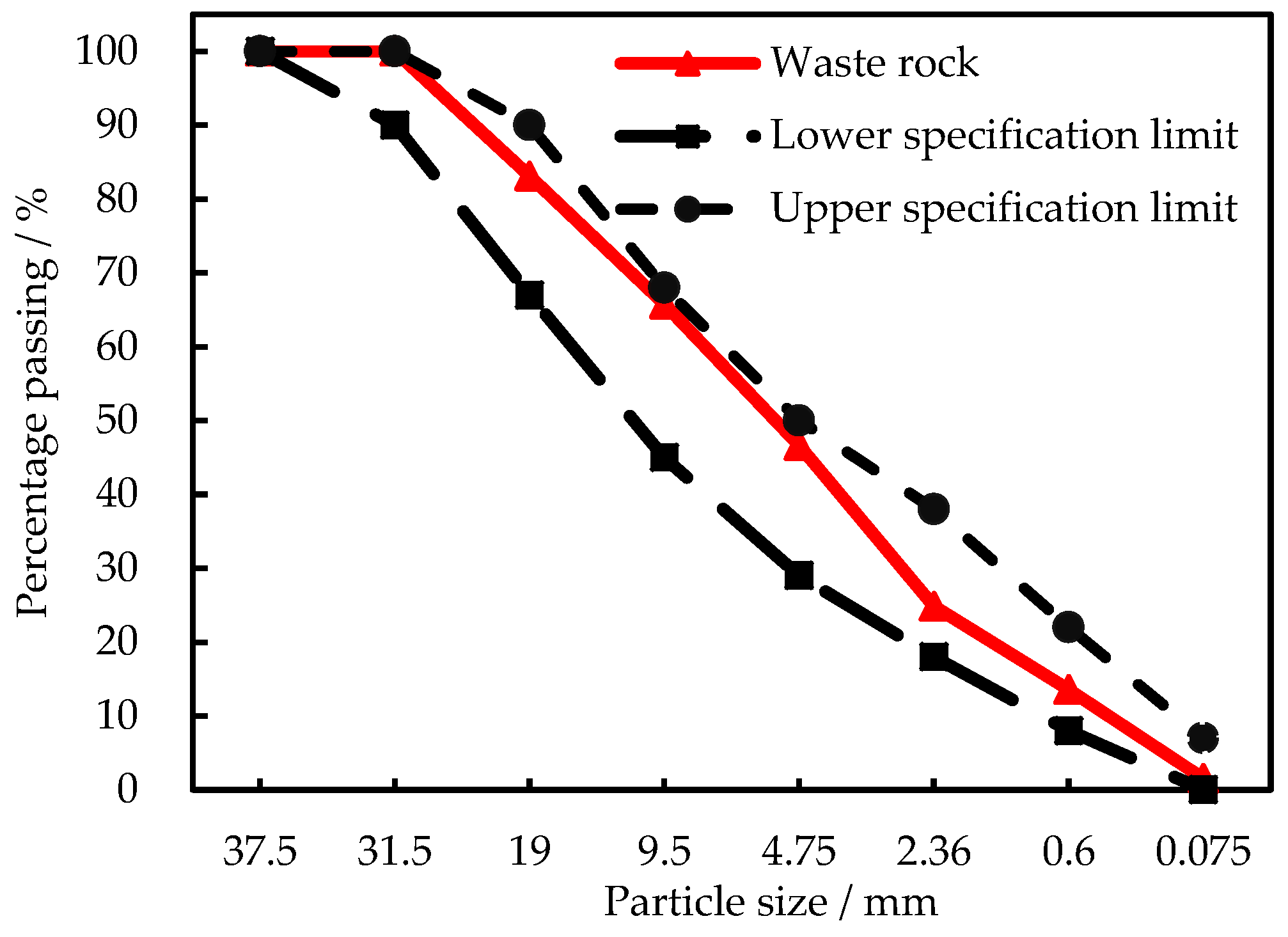
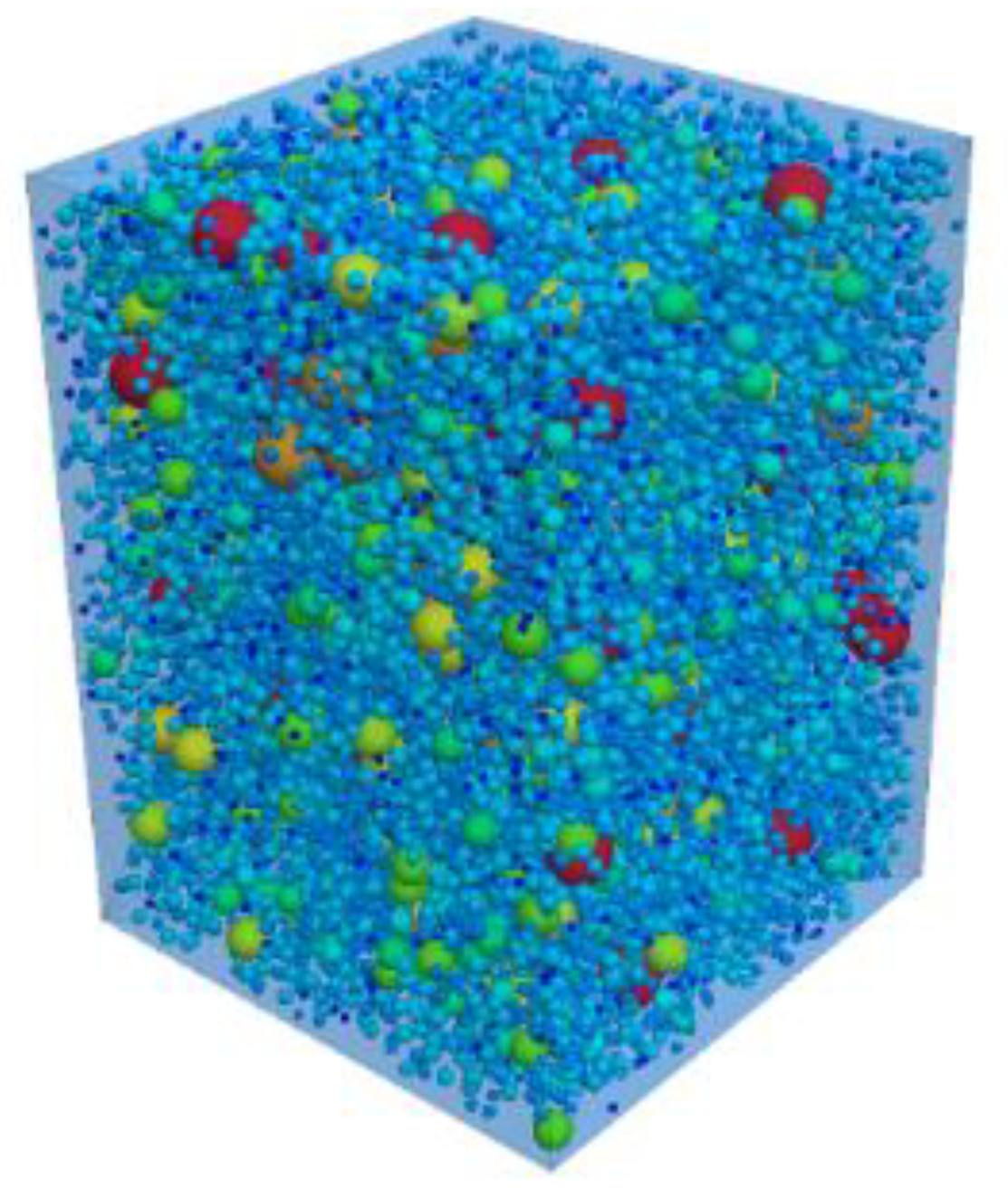
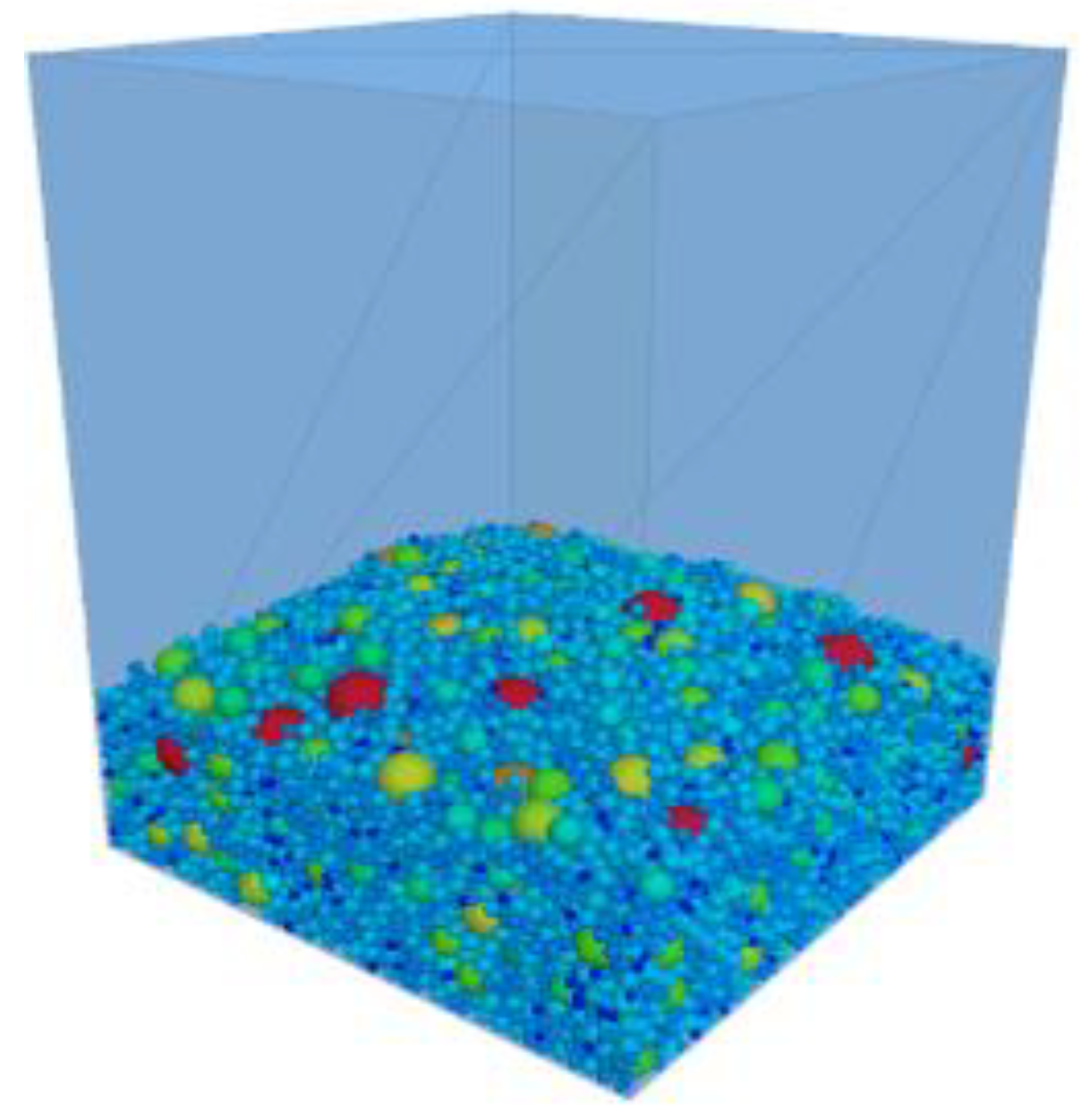
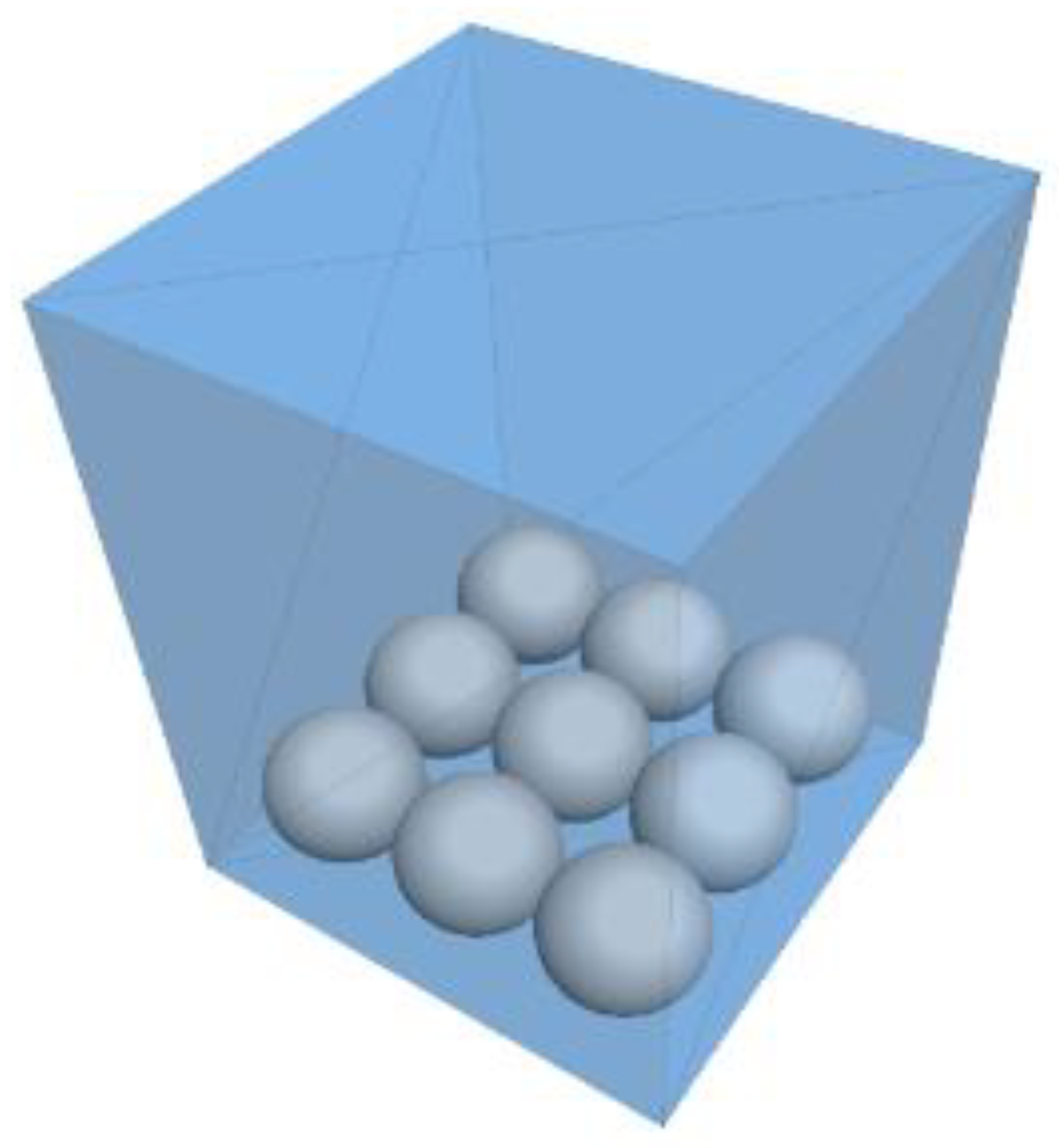
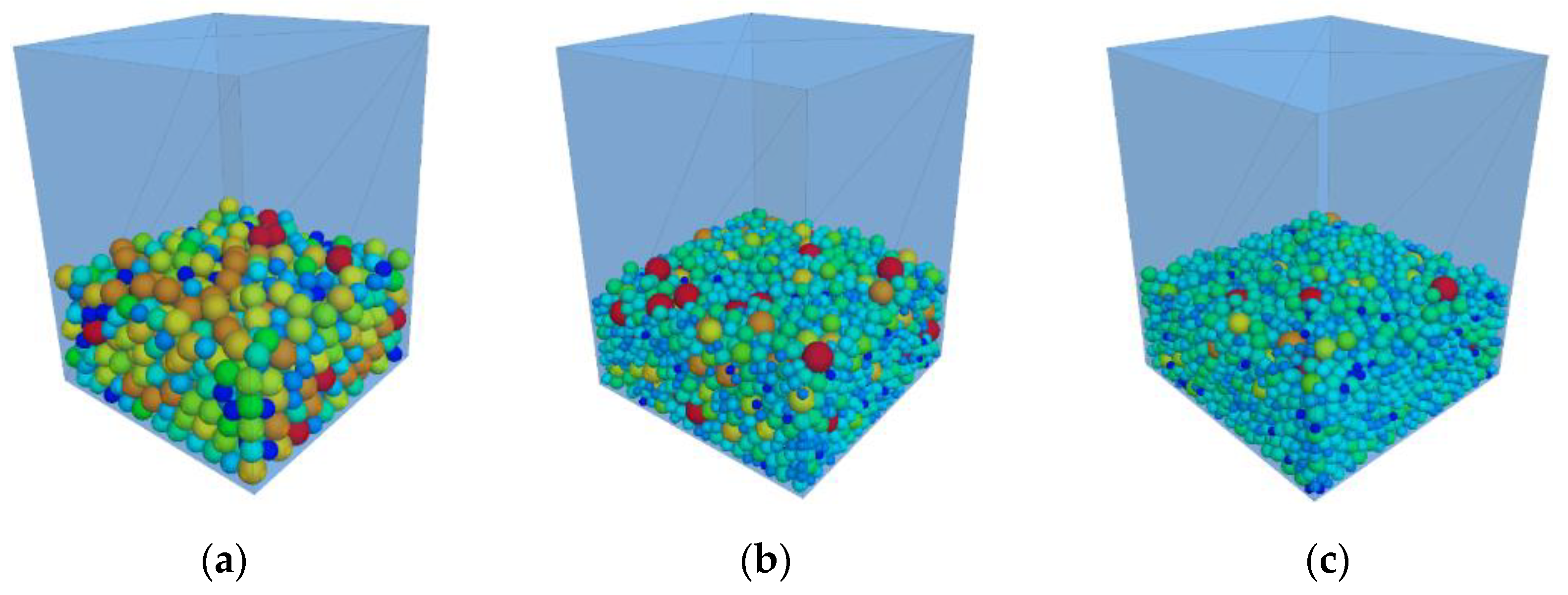



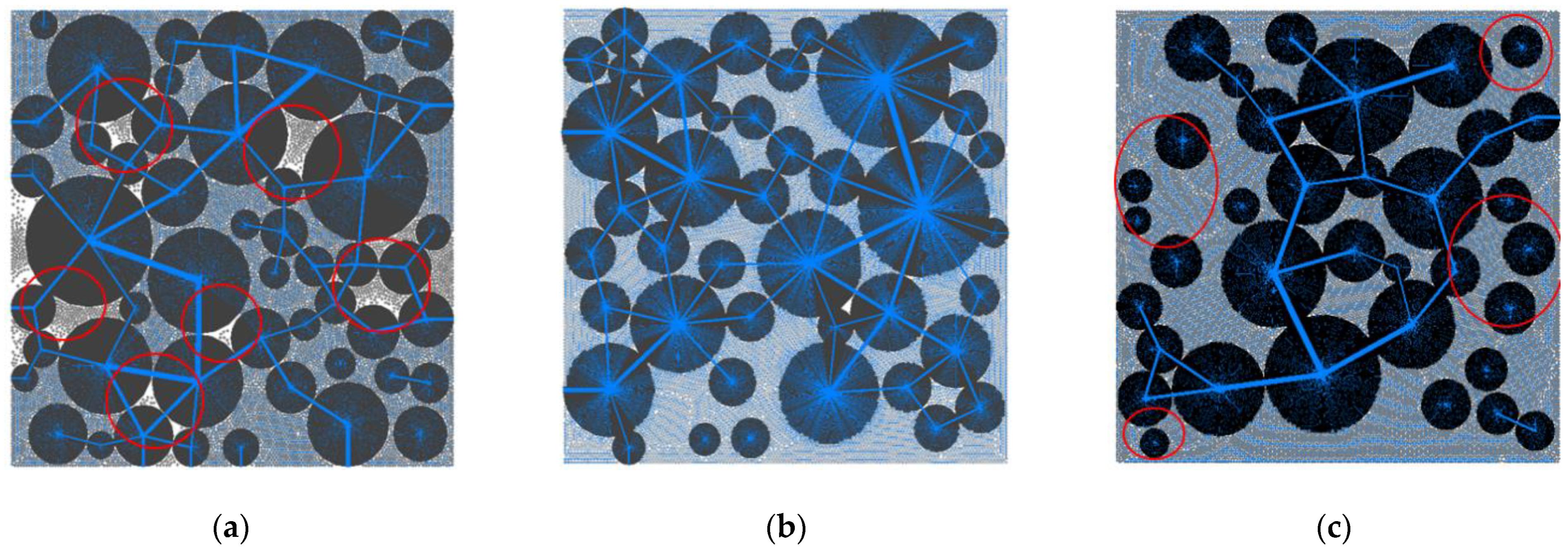

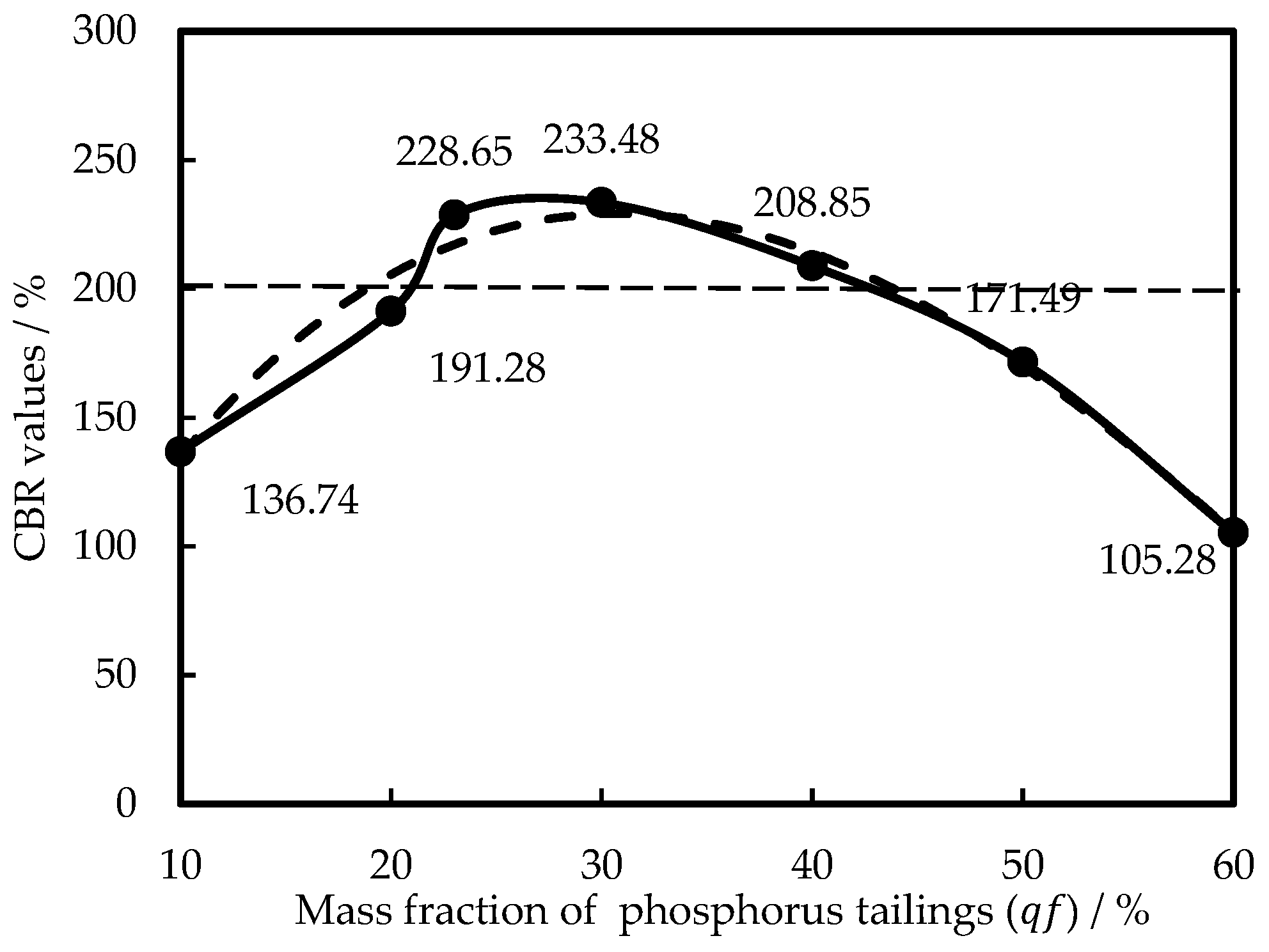
| Crushing Value/wt% | Apparent Density/kg/m3 | Stone Powder Content/wt% | Sediment Percentage/wt% |
|---|---|---|---|
| 15.8 | 2850 | 0.3 | 0.3 |
| Filling Factor λ | Judge | Mixture Structure State | |
|---|---|---|---|
| 50 | 3.08 | λ > 1 | Suspension-dense structure |
| 30 | 1.30 | λ > 1 | Suspension-dense structure |
| 27 | 1.10 | λ ≈ 1 | Skeleton-dense structure |
| 23 | 0.90 | λ ≈ 1 | Skeleton-dense structure |
| 20 | 0.77 | λ < 1 | Skeleton-void structure |
Publisher’s Note: MDPI stays neutral with regard to jurisdictional claims in published maps and institutional affiliations. |
© 2022 by the authors. Licensee MDPI, Basel, Switzerland. This article is an open access article distributed under the terms and conditions of the Creative Commons Attribution (CC BY) license (https://creativecommons.org/licenses/by/4.0/).
Share and Cite
Liu, Z.; Li, J.; Zhao, Q.; Wang, J.; Liu, T.; Zhang, Q. Gradation Design of Phosphorus Tailing–Graded Waste Rock Subgrade Filling Using Discrete Element Method. Minerals 2022, 12, 573. https://doi.org/10.3390/min12050573
Liu Z, Li J, Zhao Q, Wang J, Liu T, Zhang Q. Gradation Design of Phosphorus Tailing–Graded Waste Rock Subgrade Filling Using Discrete Element Method. Minerals. 2022; 12(5):573. https://doi.org/10.3390/min12050573
Chicago/Turabian StyleLiu, Zudong, Jianqiu Li, Qinglin Zhao, Jiacai Wang, Taohua Liu, and Qinggang Zhang. 2022. "Gradation Design of Phosphorus Tailing–Graded Waste Rock Subgrade Filling Using Discrete Element Method" Minerals 12, no. 5: 573. https://doi.org/10.3390/min12050573






